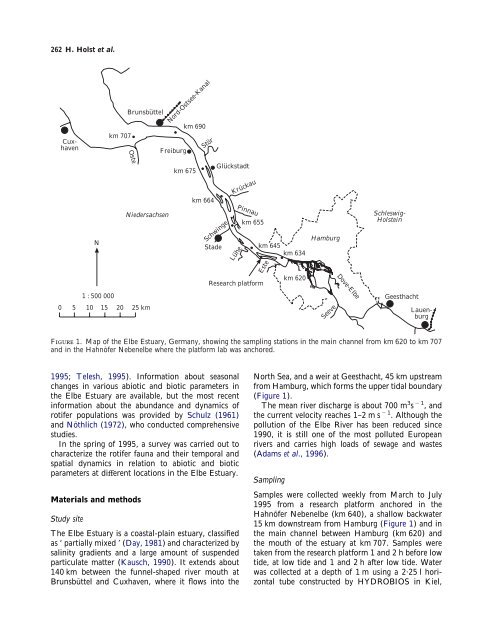Temporal and Spatial Dynamics of Planktonic Rotifers in the Elbe ...
Temporal and Spatial Dynamics of Planktonic Rotifers in the Elbe ...
Temporal and Spatial Dynamics of Planktonic Rotifers in the Elbe ...
Create successful ePaper yourself
Turn your PDF publications into a flip-book with our unique Google optimized e-Paper software.
262 H. Holst et al.<br />
Lauenburg<br />
Cuxhaven<br />
..<br />
Brunsbuttel<br />
km 707<br />
Oste<br />
Nord-Ostsee-Kanal<br />
Freiburg<br />
km 690<br />
..<br />
Stor<br />
..<br />
Gluckstadt<br />
km 675<br />
km 664<br />
Krückau<br />
N<br />
Niedersachsen<br />
Schw<strong>in</strong>ge<br />
Stade<br />
..<br />
P<strong>in</strong>nau<br />
Luhe<br />
km 655<br />
km 645<br />
km 634<br />
Hamburg<br />
Schleswig-<br />
Holste<strong>in</strong><br />
Este<br />
Research platform<br />
km 620<br />
Dove-<strong>Elbe</strong><br />
1 : 500 000<br />
0 5 10 15 20 25 km<br />
Seeve<br />
Geesthacht<br />
FIGURE 1. Map <strong>of</strong> <strong>the</strong> <strong>Elbe</strong> Estuary, Germany, show<strong>in</strong>g <strong>the</strong> sampl<strong>in</strong>g stations <strong>in</strong> <strong>the</strong> ma<strong>in</strong> channel from km 620 to km 707<br />
<strong>and</strong> <strong>in</strong> <strong>the</strong> Hahnöfer Nebenelbe where <strong>the</strong> platform lab was anchored.<br />
1995; Telesh, 1995). Information about seasonal<br />
changes <strong>in</strong> various abiotic <strong>and</strong> biotic parameters <strong>in</strong><br />
<strong>the</strong> <strong>Elbe</strong> Estuary are available, but <strong>the</strong> most recent<br />
<strong>in</strong>formation about <strong>the</strong> abundance <strong>and</strong> dynamics <strong>of</strong><br />
rotifer populations was provided by Schulz (1961)<br />
<strong>and</strong> Nöthlich (1972), who conducted comprehensive<br />
studies.<br />
In <strong>the</strong> spr<strong>in</strong>g <strong>of</strong> 1995, a survey was carried out to<br />
characterize <strong>the</strong> rotifer fauna <strong>and</strong> <strong>the</strong>ir temporal <strong>and</strong><br />
spatial dynamics <strong>in</strong> relation to abiotic <strong>and</strong> biotic<br />
parameters at different locations <strong>in</strong> <strong>the</strong> <strong>Elbe</strong> Estuary.<br />
Materials <strong>and</strong> methods<br />
Study site<br />
The <strong>Elbe</strong> Estuary is a coastal-pla<strong>in</strong> estuary, classified<br />
as ‘ partially mixed ’ (Day, 1981) <strong>and</strong> characterized by<br />
sal<strong>in</strong>ity gradients <strong>and</strong> a large amount <strong>of</strong> suspended<br />
particulate matter (Kausch, 1990). It extends about<br />
140 km between <strong>the</strong> funnel-shaped river mouth at<br />
Brunsbüttel <strong>and</strong> Cuxhaven, where it flows <strong>in</strong>to <strong>the</strong><br />
North Sea, <strong>and</strong> a weir at Geesthacht, 45 km upstream<br />
from Hamburg, which forms <strong>the</strong> upper tidal boundary<br />
(Figure 1).<br />
The mean river discharge is about 700 m 3 s 1 , <strong>and</strong><br />
<strong>the</strong> current velocity reaches 1–2 m s 1 . Although <strong>the</strong><br />
pollution <strong>of</strong> <strong>the</strong> <strong>Elbe</strong> River has been reduced s<strong>in</strong>ce<br />
1990, it is still one <strong>of</strong> <strong>the</strong> most polluted European<br />
rivers <strong>and</strong> carries high loads <strong>of</strong> sewage <strong>and</strong> wastes<br />
(Adams et al., 1996).<br />
Sampl<strong>in</strong>g<br />
Samples were collected weekly from March to July<br />
1995 from a research platform anchored <strong>in</strong> <strong>the</strong><br />
Hahnöfer Nebenelbe (km 640), a shallow backwater<br />
15 km downstream from Hamburg (Figure 1) <strong>and</strong> <strong>in</strong><br />
<strong>the</strong> ma<strong>in</strong> channel between Hamburg (km 620) <strong>and</strong><br />
<strong>the</strong> mouth <strong>of</strong> <strong>the</strong> estuary at km 707. Samples were<br />
taken from <strong>the</strong> research platform 1 <strong>and</strong> 2 h before low<br />
tide, at low tide <strong>and</strong> 1 <strong>and</strong> 2 h after low tide. Water<br />
was collected at a depth <strong>of</strong> 1 m us<strong>in</strong>g a 2·25 l horizontal<br />
tube constructed by HYDROBIOS <strong>in</strong> Kiel,
















